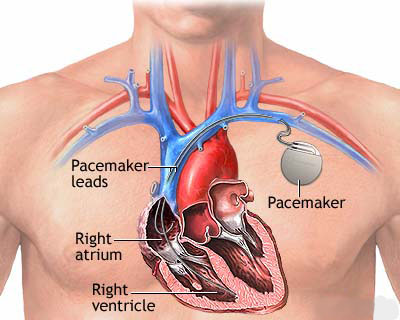Pacemaker
Information
A pacemaker, also know as artificial pacemaker, permanent pacemaker or internal pacemaker is a small, battery-operated device that helps the heart beat regularly and at an appropriate rate.
A pacemaker generally has two parts:
Generator - contains the battery and the information to control the heartbeat
Leads - wires used to connect the heart to the generator and send the electrical impulses to the heart to tell it to beat
Today's generators weigh a little less than an ounce (30 grams). The pacemaker's battery can last about 7 to 8 years. It will be regularly checked by your doctor, and replaced when necessary.
Traditional pacemakers help control the right side of the heart to control the heart beat. This is called AV synchronization. A special type of pacemaker, called a biventricular pacemaker, works on both sides of the heart. It synchronizes the right and left chambers (ventricles) of the heart and keeps them pumping together. This is called cardiac resynchronization therapy. All of today's biventricular pacemakers can also work as an implantable cardio-defibrillator (ICD).
Implant Surgery
A pacemaker must be implanted under the skin. This procedure usually takes about 1 hour. You will be given a sedative to help you relax during the procedure. Pain medicine will be given during the procedure.
A small cut is made, usually on the left side of the chest. The health care provider uses x-rays to place the wires (leads) in the heart. After the leads are in place, they are connected to the pacemaker. The pacemaker is placed into the chest area, and the skin around it is closed with stitches. Most patients go home within 1 day of the procedure.

Complications
Complications of pacemaker surgery include but are not limited to bleeding, infection, dropped lung (uncommon), abnormal heart rhythms, and puncture of heart leading to bleeding around the heart (rare).
A pacemaker can usually sense if the heartbeat is above a certain level, at which point it will automatically turn off. Likewise, the pacemaker can sense when the heartbeat slows down too much, and will automatically turn back on in order to start pacing again.
Why pacemakers are used
A pacemaker is often the treatment of choice for people who have a heart condition that causes their heart to beat too slowly (bradycardia).
Less commonly, pacemakers may also be used to stop an abnormally rapid heart rate (tachycardia).
Biventricular pacemakers have been used to treat severe heart failure.
Interference
There are generally only a few devices in the environment today that which can interfere with a pacemaker.
• Arc welding equipment and equipment with powerful magnets (MRI machine)have the potential to interfere with the pace generator.
• Most home appliances, such as a microwave, do NOT interfere with a pacemaker.
• Cell phones in the U.S. do NOT interfere with pacemakers, but you should still keep them away from the pacemaker area (for example, do NOT store your cell phone in your shirt pocket).
• Each manufacturer has specific recommendations in regard to the environmental entities that may have a harmful effect on the pacemaker.
The American Heart Association recommends that persons with a pacemaker should pay close attention to their surroundings to make sure there are not any devices that may interfere. You should always carry identification with you that says you have a pacemaker.
Acknowledgements
Heart Rhythm Specialists of South Florida gives special thanks to the National Library of Medicine, Wikipedia and National Heart Lung and Blood Institute whose Web sites aided in the research of the patient educational material provided above.






